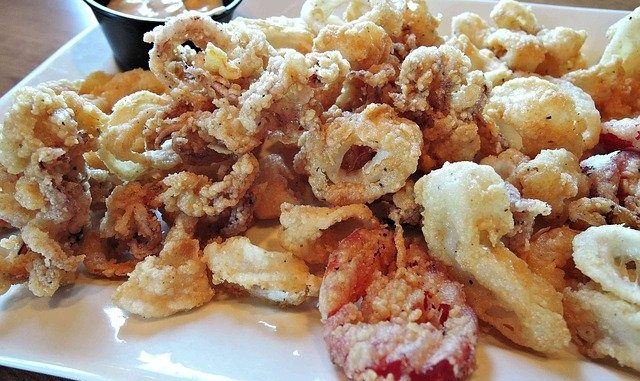
The word tempura comes from a Portuguese term for embers but the style of cooking is very much Japanese who took the idea of this particular batter. Tempura has been practiced since the mid-1500s. The Japanese have it on the menu for a catch-all coating. It is famed for its crunch.
All sorts of foods are battered including seafood such as squid, prawns, pieces of fish etc. The other food popularised by this method of cooking is to coat strips of vegetables as finger food or for dipping in various sauces. We have provided two recipes – one which is conventional and another which would be treated as a classical tempura.
Squid is popular because it is a tricky food to cook at that best of times but lends itself very well to very rapid frying. It cooks fast in a fryer. Squid you either have to cook very quickly, or slow and low. Anything in between and it’s chewy and rubbery.
So the quick frying in tempura batter is ideal for squid. Of course if you would rather use other seafood, you can use this batter with shrimp, pieces of lobster, oysters, clams, small fish, or pieces of larger fish.
[Please note we are an affiliate marketing partner and will make a sales commission if you purchase any items through our affiliate links. Please read our affiliate disclosure]
Equipment:
Ingredients For Tempura Batter:
- 200g self-raising flour OR 140g cornflower with 60g of plain flour
- 1.5g salt
- 50g cornflower
- 400ml/13 fluid oz. cold still or carbonated/sparkling water
- neutral oil such as groundnut oil for deep frying
- crushed ice is also useful to hand.
For the foods that are to be battered use:
1 pound of peeled shrimps, calamari rings and king prawns (leave the tails on), 4 cups of vegetables such as onion rings, sliced carrots, red or green pepper slices, courgette/zucchini slices or spears, peeled and sliced sweet potatoes, mushrooms, broad beans, string beans or strips of asparagus.
Preparation:
- The batter is prepared by placing the flour and salt into a bowl. Add the really cold water and ice if available, and mix to generate the batter until it has the consistency of cream.
- Leave the batter in the fridge for about 15 minutes so that the flour fully absorbs the water. The consistency of the batter is adjusted with either adding extra water or flour.
- Have a heat fryer set to a temperature of 200ºC or just fill a saucepan a quarter full with the neutral oil to the same temperature.
- With a fork, stab a vegetable or squid ring so that it is firmly on the tines of the fork. Use fondue forks as well.
- Take the food and dunk in the very hot oil to fry. The alternative is to take small portions of the food and add to the oil. Leave to crisp up for a few minutes.
- Remove and dry on a paper towel. It may be too hot to eat at that moment so let the battered food cool a little.
- The batter must be used as soon as it’s made otherwise it will become too dough-like and fry like a jelly!
Issues:
To get a decent crispy batter, make sure the oil is as hot as possible. Frying oil is often useless after a number of runs with it as any fish and chip shop will tell you. The flour and water mix can also end up as a dough if the proportions of flour to water are not right and it must be used immediately it is made. It will not keep.
This recipe below was adapted from “Japanese Country Cookbook” by Russ Rudzinski and is for a more traditional type of tempura.
Traditional Tempura
Yield: 4 servings
Ingredients:
- 1 cup plain or all-purpose flour
- 1 cup chilled water
- 1 or 2 egg yolks (not the whole egg).
- pinch of salt
- 1 teaspoon granulated sugar
- 1/2 teaspoon baking powder
- Vegetable oil
A typical spicy dipping sauce would have these ingredients:
- 1tbsp tomato ketchup
- 2 tbsp sweet chilli sauce
- 2 tbsp mirin
- 2-3 tbsp Japanese soy sauce
Preparation:
1. In a medium bowl, combine flour, water, egg, salt, sugar and baking powder. Whisk thoroughly (or use egg beaters) until mixture achieves the consistency of whipping cream.
Refrigerate 15 minutes.
If mixture becomes too thick, stir in a little water until the consistency again resembles whipping cream.
2. Pour oil into a large pot to a depth of at least 2 inches. Bring temperature to 375 degrees (if you don’t have a thermometer, put a drop of the batter into the oil; it should fall to the bottom for a second, then rise to the top and sizzle gently. If it stays on the bottom the oil is too cold but if it immediately sizzles on top, it is too hot.
3. Dip shrimp or vegetables in batter and fry a few at a time. We know the temperature should drop to about 350 degrees.
Flip a few times in the oil and fry on both sides until a light golden brown and crisp. Remove with a wire-mesh spider, strainer, slotted spoon or chopsticks to paper towels to drain. Serve with dipping sauce on the side, if desired.
Per serving (using shrimp): 468 calories; 29 g fat; 23 g saturated fat; 229 mg cholesterol; 28 g protein; 28 g carbohydrate; 1 g sugar; 1 g fiber; 193 mg sodium; 138 g calcium.

Leave a Reply